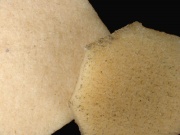Difference between revisions of "Rubber eraser"
Jump to navigation
Jump to search
m (Text replace - "\[http:\/\/cameo\.mfa\.org\/materials\/fullrecord\.asp\?name=([^\s]+)\s(.*)\]" to "$2") |
|||
| Line 2: | Line 2: | ||
== Description == | == Description == | ||
| − | An eraser made from [[rubber | + | An eraser made from [[rubber (natural, vulcanized)|natural rubber]]. Erasers made from caoutchouc were first used in 1770 by Joseph Priestley. He dubbed the small elastic balls as 'rubbers' because they could remove pencil marks with a simple rubbing action. |
== Synonyms and Related Terms == | == Synonyms and Related Terms == | ||
| Line 8: | Line 8: | ||
goma de borrar de caucho (Esp.); gomme (Fr.), gomme à effacer (Fr.); gomma da cancellare (It) | goma de borrar de caucho (Esp.); gomme (Fr.), gomme à effacer (Fr.); gomma da cancellare (It) | ||
| − | == | + | == Resources and Citations == |
* Hermann Kuhn, ''Conservation and Restoration of Works of Art and Antiquities'', Butterworths, London, 1986 | * Hermann Kuhn, ''Conservation and Restoration of Works of Art and Antiquities'', Butterworths, London, 1986 | ||
Latest revision as of 18:20, 4 August 2020
Description
An eraser made from natural rubber. Erasers made from caoutchouc were first used in 1770 by Joseph Priestley. He dubbed the small elastic balls as 'rubbers' because they could remove pencil marks with a simple rubbing action.
Synonyms and Related Terms
goma de borrar de caucho (Esp.); gomme (Fr.), gomme à effacer (Fr.); gomma da cancellare (It)
Resources and Citations
- Hermann Kuhn, Conservation and Restoration of Works of Art and Antiquities, Butterworths, London, 1986
- Ivan Amato, Stuff: The Materials the World is Made of, Avon Books, New York, 1997
